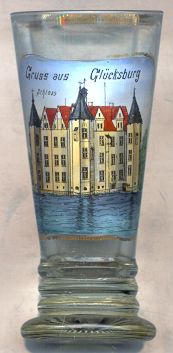

|
| DEUTSCHLAND | GERMANY |
| Bundesland: Schleswig-Holstein | |
| Kreis: Schleswig-Flensburg |
 Glücksburg is situated at the Flensburger Förde (Firth of Flensburg) east of Flensburg.
Glücksburg is situated at the Flensburger Förde (Firth of Flensburg) east of Flensburg.
The oldest traces of human settlements date from the Neolithic and Bronze Ages. In 1209/1210 Cistercian monks founded a new monastery here, which initiated the modern period of colonization. In 1544 the Duchies of Schleswig and Holstein, which at that time beloged to the Danish Crown, were divided between King Christian III and his brothers. Christian thus became Duke of Schleswig-Holstein-Glücksburg. Christian's third son, Johann the Younger obtained one third of the area in 1564 and became Duke of Schleswig-Holstein-Sonderburg. The Third Partition of Schleswig-Holstein-Sonderburg in 1627 gave rise to the Duchy of Schleswig-Holstein-Beck, which in 1825 was renamed Schleswig-Holstein-Sonderburg-Glücksburg (younger line). When King Frederik VII from the Royal Danish line of the House of Oldenburg died without male heir, Christian IX from the line of Schleswig-Holstein-Sonderburg-Glücksburg succeeded him as King of Denmark. His daughters married European sovereigns, his sons became monarchs in their own right: his oldest son Frederik succeeded him as King of Denmark (Frederik VIII), Princess Alexandra became Queen Consort of Edward VII of the United Kingdom, Prince George became King of Greece (George I), Princess Marie Sophie Dagmar (Maria Fjodorovna) married the later Czar Alexander III of Russia, Princess Thyra married Ernst August of Hannover, 3rd Duke of Cumberland. Christian's grandsons include Czar Nicholas II of Russia, Constantine I of Greece, George V of the United Kingdom, Christian X of Denmark and Haakon VII of Norway. Christian thus became named the 'father-in-law of Europe'. After the Schleswig-Holstein War of 1848–1851 Denmark had retained the sovereignty over the country, but had to accept Schleswig-Holstein as an independent, separate identity. In 1863 Christian IX tried to annex Schleswig which prompted the German–Danish War of 1864. The war ended with a defeat of Denmark. The Treaty of Gastein (Gasteiner Konvention) divided the country between Prussia, which obtained Schleswig and Lauenburg, and Austria, which obtained Holstein. Already one year later Holstein also fell to Prussia.
In the late 19th century Glücksburg became as a sea-side resort. The Holnis peninsula just northeast of Glücksburg is an important seabird breading area. The northern tip of Holnis is the northernmost point of the German mainland.
 Glückburg castle is one of the most significant castles in Europe.
The moated castle was founded in 1582 by Duke Johann the Younger of Schleswig-Holstein-Sonderburg.
It was built in late Renaissance style on the foundations of a former monastery.
The interior decorations mostly date from the Baroque period.
Glückburg castle is one of the most significant castles in Europe.
The moated castle was founded in 1582 by Duke Johann the Younger of Schleswig-Holstein-Sonderburg.
It was built in late Renaissance style on the foundations of a former monastery.
The interior decorations mostly date from the Baroque period.
![[scale]](lineal.jpg)